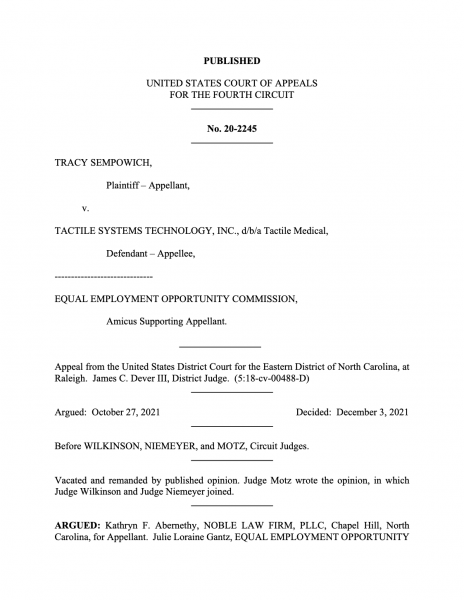A federal appeals court this month ruled in favor of the plaintiff in an employment discrimination case that addresses common defenses and legal issues that arise in Title VII, Equal Pay Act, and related laws. The U.S. Court of Appeals for the Fourth Circuit issued its decision in Sempowich v. Tactile Systems Technology, Inc., No. 20-2245 (4th Cir. Dec. 3, 2021), and its legal analysis instructive for employees and employment discrimination lawyers on a number of issues.
The plaintiff-appellant (Sempowich) was represented by the Noble Law Firm and the defendant-appellee (Tactile Systems) was represented by Stinson LLP. The Equal Employment Opportunity Commission (EEOC) participated as amicus curiae supporting the plaintiff-appellant.
Talk with an employment discrimination lawyer to learn more about these issues if you have experienced discrimination or retaliation at work.
Factual Summary Of Employment Discrimination Case
The case involves an employee, Tracy Sempowich, who worked with Tactile Systems Technology for many years in a number of roles, including regional sales manager. A key issue addressed by the appellate court is whether Sempowich had met Tactile System’s job performance goals.
Tactile Systems claimed Sempowich did not meet the goals and that her insufficient job performance spanned multiple years. Conversely, Sempowich presented evidence showing that the company “consistently viewed her as a top performer.” For example:
-
In two recent performance evaluations, her supervisor noted her “exceptional strengths” in several categories;
-
Tactile Systems repeatedly gave her awards;
-
the company granted her a discretionary equity grant and a significant salary raise; and
-
Tactile Systems actually rated Sempowich higher than a male colleague (who the company later promoted above Sempowich)
Tactile Systems eventually told Sempowich that, based on her sub-par job performance, it would reassign her to a position that she considered to be a demotion. Sempowich then filed a discrimination complaint with human resources. About one month later, Sempowich was told she had to accept the new role or she would be fired. She did not accept the new role and her employment ended.
Sempowich later filed an employment discrimination case against Tactile Systems under Title VII of the 1964 Civil Rights Act, the Equal Pay Act, and related state laws.
The federal trial court granted Tactile Systems’ motion for summary judgment, which meant the case was dismissed before a jury trial occurred. Sempowich then filed her appeal of the employment discrimination case to the U.S. Court of Appeals for the Fourth Circuit.
The Appellate Rulings In This Employment Discrimination Case
The first issue decided by the appellate court centered on whether Sempowich established a prima facie case of employment discrimination under Title VII. To prove this initial/prima facie case, an employee needs to show that: (1) she is a member of a protected class; (2) her employer took an adverse action against her; (3) she had been fulfilling her employer’s legitimate expectations at the time of the adverse action; and (4) the adverse action occurred under circumstances that raise a reasonable inference of discrimination, including because the employer left open the position or replaced the plaintiff with someone outside the protected class. Bing v. Brivo Sys., LLC, 959 F.3d 605, 616 n. 8 (4th Cir. 2020).
Once the employee makes out a prima facie, the burden shifts to the employer to articulate a non-discriminatory reason for its actions. If the employer does so—and they almost always are able to produce some explanation—then the burden shifts back to the employee to prove that the explanation “was actually a pretext for discrimination.”
Did The Employee Fulfill The Employer’s Legitimate Performance Expectations?
One of the appellate court’s rulings addressed a common issue that plays out in employment discrimination cases: was the employee meeting the company’s legitimate job performance expectations at the time it took the adverse action against them?
Notably, to meet this element, an employee need not “show that [s]he was a perfect or model employee. Rather, a plaintiff must show only that [s]he was qualified for the job and she [s]he was meeting [her]] employer’s legitimate expectactions.” Haynes v. Waste Connections, Inc., 922 F.3d 219, 225 (4th Cir. 2019). In Sempowich’s case, the appellate court determined that an issue of material fact existed on this point, making summary judgment in favor of the employer inappropriate.
In particular, a dispute existed about whether she was meeting the legitimate expectations of Tactile Systems given that she received high performance ratings and awards, as well as a salary raise and an equity grant. The company took certain of these actions right before it made the decision to reassign her to a different position, which Sempowich viewed as an effective demotion. Based on this evidence, the appellate court ruled that Sempowich must have the opportunity to present her case to a jury.
Was The Company’s Explanation Simply A Pretext For Employment Discrimination?
The next issue faced by the appellate court is also a common theme in many employment discrimination cases. That is, was the employer’s explanation for why it took an adverse action against the employee simply a pretext for discrimination?
“To show pretext, a plaintiff may show that an employer’s proffered nondiscriminatory reasons for the termination are inconsistent over time, false, or based on mistakes of fact.” Haynes, 922 F.3d at 225.
The trial court had ruled that no genuine dispute of material fact remained regarding pretext. But the appeals court disagreed and found that Sempowich had produced evidence showing that Tactile System’s explanations were false and/or inconsistent. One aspect that the appellate court found compelling was that Tactile Systems had replaced Sempowich with a male colleague who received lower job performance ratings than her. As a result, “a jury might well conclude it unlikely that an employer who reassigned an employee [Sempowich] solely because it believed she performed poorly would replace her with an employee whose performance it consistently rated as worse.” (emphasis in original). Likewise, the appellate court found that Sempowich had produced evidence that Tactile Systems actually believed her performance was good, including the performance ratings, awards, salary raise, and equity grant that the company had bestowed on her.
Finally, the appellate court determined that the trial court erred when it applied the “same-actor inference” to dismiss Sempowich’s employment discrimination case. The same-actor inference arises where the employee’s “hirer and firer are the same individual and the termination of employment occurs within a relatively short time span following the hiring,” which result in a strong inference that discrimination was not a determining factor. Proud v. Stone, 945 F.2d 796, 797 (4th Cir. 1991). The trial court wrongly applied this same-actor inference because the appellate court found in Sempowich’s case that the reassignment occurred about eight years after she was hired; a far cry from the six-month span in Pride v. Stone.
As a result, Sempowich’s employment discrimination case will be returned to the trial court for a jury trial.
The Employment Retaliation Claims
Sempowich’s lawsuit also involved Title VII employment retaliation claims, in which she asserted that the company retaliated against her because filed a discrimination complaint. To prove a prima facie/initial complaint of retaliation, an employee must show: “(i) that [she] engaged in protected activity, (ii) the [her employer] took adverse action against [her], and (iii) that a causal relationship existed between the protected activity and the adverse employment activity.” Foster v. Univ. of Md.-E. Shore, 787 F.3d 243, 250 (4th Cir. 2015). If this showing is made, the employer must then demonstrate that “its purportedly retaliatory action was in fact the result of a legitimate non-retaliatory reason.” Id. If this burden is met, then the employee has to prove that these nonretaliatory reasons “were not its true reasons but were a pretext for discrimination.” Id.
The trial court determined that Sempowich did not meet the prima facie case because temporal proximity (that is, close timing) alone cannot establish a causal relationship under step 3 above, and also that no temporal proximity existed in her case. The appeals court rejected both of these findings.
First, the appellate court found that “we have made abundantly clear that temporal proximity suffices to show a causal relationship.” So, if an employee shows that the employer took an adverse action soon after it learns of the protected activity, this alone can establish a prima facie case of retaliation.
Second, the appellate court ruled that temporal proximity existed in Sempowich’s case because Tactile told her that she could either accept the reassignment or be fired (the adverse action) within about a month of when she complained about discrimination. Accordingly, this Title VII retaliation claim will also be heard by a jury.
The Equal Pay Act Claims
The final issue considered by the appellate court was Sempowich’s Equal Pay Act claim. A prima facie case of Equal Pay Act discrimination involves showing “(1) the defendant-employer paid different wages to an employee of the opposite sex (2) for equal work on jobs requiring equal skill, effort, and responsibility, which jobs (3) all are performed under similar working conditions.” EEOC v. Md. Ins. Admin., 879 F.3d 114, 120 (4th Cir. 2018).
The legal issue in play here was how to determine the proper metric for wage discrimination under the Equal Pay Act: should it be (1) the rate at which an employer pays the employee; or (2) the employee’s total wages.
Looking at the Equal Pay Act’s statutory language, the appellate court had little trouble finding that wage rate, rather than total wages, is the proper metric.
Key takeaways in this employment discrimination case
-
In a Title VII employment discrimination case, an employee can show they met the employer’s legitimate performance expectations through, among other things, high-performance ratings, awards, salary raises, and stock grants.
-
The employee does not have to show they were a perfect employee; rather, simply that they were qualified for the role and meeting the legitimate expectations.
-
The “same-actor inference” in the pretext analysis for a Title VII employment discrimination case applies only if the hiring and adverse action occur “within a relatively short time span following the hiring.”
-
In a Title VII retaliation case, temporal proximity (that is, close timing) alone can establish a causal relationship to prove a prima facie case of retaliation.
-
In an Equal Pay Act case, the proper metric to determine if wage discrimination occurred is the employee’s wage rate, rather than total wages.
As this case returns to the lower court for a jury trial, it will be one to watch.




 />i
/>i

